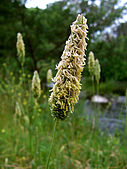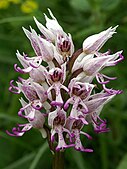
A | B | C | D | E | F | G | H | CH | I | J | K | L | M | N | O | P | Q | R | S | T | U | V | W | X | Y | Z | 0 | 1 | 2 | 3 | 4 | 5 | 6 | 7 | 8 | 9
| Flowering plant Temporal range:
| |
|---|---|
| Scientific classification | |
| Kingdom: | Plantae |
| Clade: | Tracheophytes |
| Clade: | Spermatophytes |
| Clade: | Angiosperms |
| Groups (APG IV)[1] | |
| |
| Synonyms | |
Flowering plants are plants that bear flowers and fruits, and form the clade Angiospermae (/ˌændʒiəˈspərmiː/),[5][6] commonly called angiosperms. They include all forbs (flowering plants without a woody stem), grasses and grass-like plants, a vast majority of broad-leaved trees, shrubs and vines, and most aquatic plants. The term "angiosperm" is derived from the Greek words ἀγγεῖον / angeion ('container, vessel') and σπέρμα / sperma ('seed'), meaning that the seeds are enclosed within a fruit. They are by far the most diverse group of land plants with 64 orders, 416 families, approximately 13,000 known genera and 300,000 known species.[7] Angiosperms were formerly called Magnoliophyta (/mæɡˌnoʊliˈɒfətə, -əˈfaɪtə/).[8]
Angiosperms are distinguished from the other seed-producing plants, the gymnosperms, by having flowers, xylem consisting of vessel elements instead of tracheids, endosperm within their seeds, and fruits that completely envelop the seeds. The ancestors of flowering plants diverged from the common ancestor of all living gymnosperms before the end of the Carboniferous, over 300 million years ago. In the Cretaceous, angiosperms diversified explosively, becoming the dominant group of plants across the planet.
Agriculture is almost entirely dependent on angiosperms, and a small number of flowering plant families supply nearly all plant-based food and livestock feed. Rice, maize, and wheat provide half of the world's calorie intake, and all three plants are cereals from the Poaceae family (colloquially known as grasses). Other families provide materials such as wood, paper and cotton, and supply numerous ingredients for traditional and modern medicines. Flowering plants are also commonly grown for decorative purposes, with certain flowers playing a significant role in many cultures.
Out of the "Big Five" extinction events in Earth's history, only the Cretaceous–Paleogene extinction event had occurred while angiosperms dominated plant life on the planet. Today, the Holocene extinction affects all kingdoms of complex life on Earth, and conservation measures are necessary to protect plants in their habitats in the wild (in situ), or failing that, ex situ in seed banks or artificial habitats like botanic gardens. Otherwise, around 40% of plant species may become extinct due to human actions such as habitat destruction, introduction of invasive species, unsustainable logging and collection of medicinal or ornamental plants. Further, climate change is starting to impact plants and is likely to cause many species to become extinct by 2100.
Distinguishing features
Angiosperms are terrestrial vascular plants; like the gymnosperms, they have roots, stems, leaves, and seeds. They differ from other seed plants in several ways.
| Feature | Description | Image |
|---|---|---|
| Flowers | The reproductive organs of flowering plants, not found in any other seed plants.[9] |  |
| Reduced gametophytes, three cells in male, seven cells with eight nuclei in female (except for basal angiosperms)[10] | The gametophytes are smaller than those of gymnosperms.[11] The smaller size of the pollen reduces the time between pollination and fertilization, which in gymnosperms is up to a year.[12] |  |
| Endosperm | Endosperm forms after fertilization but before the zygote divides. It provides food for the developing embryo, the cotyledons, and sometimes the seedling.[13] | |
| Closed carpel enclosing the ovules. | Once the ovules are fertilised, the carpels, often with surrounding tissues, develop into fruits. Gymnosperms have unenclosed seeds.[14] |  |
| Xylem made of vessel elements | Open vessel elements are stacked end to end to form continuous tubes, whereas gymnosperm xylem is made of tapered tracheids connected by small pits.[15] |  |
Diversity
Ecological diversity
- Largest and smallest
-
Eucalyptus regnans,
a tree almost 100 m tall -
Wolffia arrhiza, a rootless floating freshwater plant under 2 mm across
The largest angiosperms are Eucalyptus gum trees of Australia, and Shorea faguetiana, dipterocarp rainforest trees of Southeast Asia, both of which can reach almost 100 metres (330 ft) in height.[16] The smallest are Wolffia duckweeds which float on freshwater, each plant less than 2 millimetres (0.08 in) across.[17]
- Photosynthetic and parasitic
-
Gunnera captures sunlight for photosynthesis over the large surfaces of its leaves, which are supported by strong veins.
-
Orobanche purpurea, a parasitic broomrape with no leaves, obtains all its food from other plants.
Considering their method of obtaining energy, some 99% of flowering plants are photosynthetic autotrophs, deriving their energy from sunlight and using it to create molecules such as sugars. The remainder are parasitic, whether on fungi like the orchids for part or all of their life-cycle,[18] or on other plants, either wholly like the broomrapes, Orobanche, or partially like the witchweeds, Striga.[19]
- Hot, cold, wet, dry, fresh, salt
-
Carnegiea gigantea, the saguaro cactus, grows in hot dry deserts in Mexico and the southern United States.
-
Dryas octopetala, the mountain avens, lives in cold arctic and montane habitats in the far north of America and Eurasia.
-
Nelumbo nucifera, the sacred lotus, grows in warm freshwater across tropical and subtropical Asia.
-
Zostera seagrass grows on the seabed in sheltered coastal waters.
In terms of their environment, flowering plants are cosmopolitan, occupying a wide range of habitats on land, in fresh water and in the sea. On land, they are the dominant plant group in every habitat except for frigid moss-lichen tundra and coniferous forest.[20] The seagrasses in the Alismatales grow in marine environments, spreading with rhizomes that grow through the mud in sheltered coastal waters.[21]
- Acid, alkaline
-
Drosera anglica, a sundew, lives in nutrient-poor acid bogs, deriving nutrients from trapped insects.[22]
-
Gentiana verna, the spring gentian, flourishes in dry limestone habitats.[23]
Some specialised angiosperms are able to flourish in extremely acid or alkaline habitats. The sundews, many of which live in nutrient-poor acid bogs, are carnivorous plants, able to derive nutrients such as nitrate from the bodies of trapped insects.[22] Other flowers such as Gentiana verna, the spring gentian, are adapted to the alkaline conditions found on calcium-rich chalk and limestone, which give rise to often dry topographies such as limestone pavement.[23]
- Herbaceous, woody, climbing
-
Geranium robertianum, herb-Robert, is an annual or biennial herb of Europe and North America.
-
Betula pendula, the silver birch, is a perennial deciduous tree of Eurasia.
As for their growth habit, the flowering plants range from small, soft herbaceous plants, often living as annuals or biennials that set seed and die after one growing season,[24] to large perennial woody trees that may live for many centuries and grow to many metres in height. Some species grow tall without being self-supporting like trees by climbing on other plants in the manner of vines or lianas.[25]
Taxonomic diversity
The number of species of flowering plants is estimated to be in the range of 250,000 to 400,000.[26][27][28] This compares to around 12,000 species of moss[29] and 11,000 species of pteridophytes.[30] The APG system seeks to determine the number of families, mostly by molecular phylogenetics. In the 2009 APG III there were 415 families.[31] The 2016 APG IV added five new orders (Boraginales, Dilleniales, Icacinales, Metteniusales and Vahliales), along with some new families, for a total of 64 angiosperm orders and 416 families.[1]
The diversity of flowering plants is not evenly distributed. Nearly all species belong to the eudicot (75%), monocot (23%), and magnoliid (2%) clades. The remaining five clades contain a little over 250 species in total; i.e. less than 0.1% of flowering plant diversity, divided among nine families. The 25 most species-rich of 443 families,[32] containing over 166,000 species between them in their APG circumscriptions, are:
| Group | Family | English name | No. of spp. |
|---|---|---|---|
| Eudicot | Asteraceae or Compositae | daisy | 22,750 |
| Monocot | Orchidaceae | orchid | 21,950 |
| Eudicot | Fabaceae or Leguminosae | pea, legume | 19,400 |
| Eudicot | Rubiaceae | madder | 13,150 [33] |
| Monocot | Poaceae or Gramineae | grass | 10,035 |
| Eudicot | Lamiaceae or Labiatae | mint | 7,175 |
| Eudicot | Euphorbiaceae | spurge | 5,735 |
| Eudicot | Melastomataceae | melastome | 5,005 |
| Eudicot | Myrtaceae | myrtle | 4,625 |
| Eudicot | Apocynaceae | dogbane | 4,555 |
| Monocot | Cyperaceae | sedge | 4,350 |
| Eudicot | Malvaceae | mallow | 4,225 |
| Monocot | Araceae | arum | 4,025 |
| Eudicot | Ericaceae | heath | 3,995 |
| Eudicot | Gesneriaceae | gesneriad | 3,870 |
| Eudicot | Apiaceae or Umbelliferae | parsley | 3,780 |
| Eudicot | Brassicaceae or Cruciferae | cabbage | 3,710 |
| Magnoliid dicot | Piperaceae | pepper | 3,600 |
| Monocot | Bromeliaceae | bromeliad | 3,540 |
| Eudicot | Acanthaceae | acanthus | 3,500 |
| Eudicot | Rosaceae | rose | 2,830 |
| Eudicot | Boraginaceae | borage | 2,740 |
| Eudicot | Urticaceae | nettle | 2,625 |
| Eudicot | Ranunculaceae | buttercup | 2,525 |
| Magnoliid dicot | Lauraceae | laurel | 2,500 |
Evolution
History of classification

The botanical term "angiosperm", from Greek words angeíon (ἀγγεῖον 'bottle, vessel') and spérma (σπέρμα 'seed'), was coined in the form "Angiospermae" by Paul Hermann in 1690, including only flowering plants whose seeds were enclosed in capsules.[34] The term angiosperm fundamentally changed in meaning in 1827 with Robert Brown, when angiosperm came to mean a seed plant with enclosed ovules.[35][36] In 1851, with Wilhelm Hofmeister's work on embryo-sacs, Angiosperm came to have its modern meaning of all the flowering plants including Dicotyledons and Monocotyledons.[36][37] The APG system[31] treats the flowering plants as an unranked clade without a formal Latin name (angiosperms). A formal classification was published alongside the 2009 revision in which the flowering plants rank as the subclass Magnoliidae.[38] From 1998, the Angiosperm Phylogeny Group (APG) has reclassified the angiosperms, with updates in the APG II system in 2003,[39] the APG III system in 2009,[31][40] and the APG IV system in 2016.[1]
Phylogeny
External
In 2019, a molecular phylogeny of plants placed the flowering plants in their evolutionary context:[41]



















